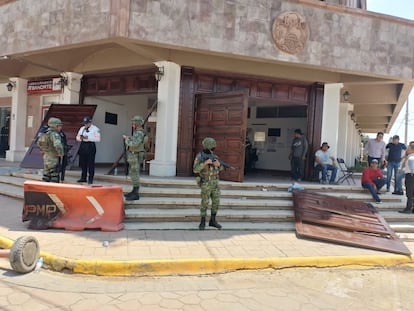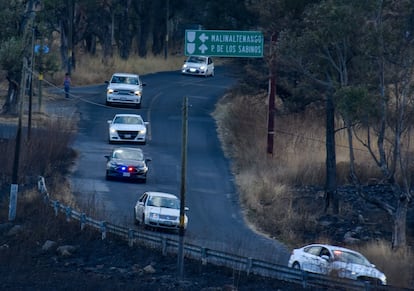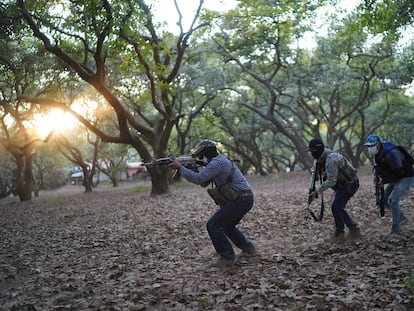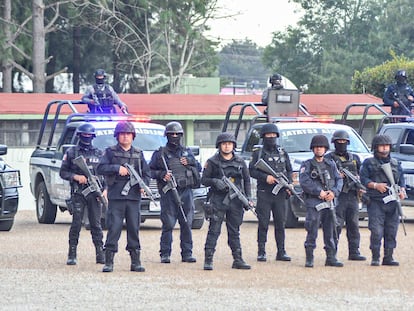In the areas surrounding Mexico City, clashes between La Familia Michoacana and the Jalisco Cartel are taking a toll
The state of Mexico – known as ‘Edomex’ to distinguish it from the name of the whole country – is not only the site of an electoral battle between the Morena party and the historic PRI. Two large cartels and some 30 local criminal groups are fighting over illegal businesses, terrorizing the marginalized population in the process

Just one year ago, a massacre in the state of Mexico – known as “Edomex,” to distinguish it from the name of the whole country – drew national attention. 11 people – allegedly members of La Familia Michoacana, a powerful drug cartel – were killed in a shootout with federal and state security agents. The agents detained another 10 people and seized several high-powered weapons. A spider monkey – dressed in military clothing – was found at the site and died of gunshot wounds. The absurd image shook the internet, provoking grief, disbelief and cruel laughter.
“The monkey was found lifeless, hugging the chest of an alleged hit man – around 20-years-old – who was killed during the shooting,” reports noted at the time. The events occurred in the municipality of Texcaltitlán, in the Tierra Caliente region of Edomex, near the border with the states of Michoacán and Guerrero. And, just months later, in March of 2023, three police officers died in an attempt to capture a group of alleged kidnappers. The chase began in the municipality of San Antonio de La Isla – located in the Toluca Valley region – and ended in the west of Mexico City. Six suspects were arrested in a joint operation between state agents and the capital police. According to the authorities in Mexico City, the kidnappers belonged to the Jalisco Nueva Generación Cartel (CJNG).
These two scenes portray the circumstances in the state of Mexico, an entity that the historic Institutional Revolutionary Party (PRI) has ruled uninterruptedly for 94 years. On June 4, the elections will be held in the state, with Morena – the ruling party at the federal level – having a real shot at victory for the first time. The state has been governed by the PRI member Alfredo del Mazo since 2017. It is one of the last strongholds of the PRI, which, over the last decade, has lost nearly all the political influence accumulated in almost a century of existence. Since President Andrés Manuel López Obrador took power in 2018 with his Morena party, all traditional parties – from the PRI to the PAN – have lost large amounts of their support.
That being said, the political fight in the state that surrounds Mexico City is not the only one being fought. Its vast geography is also plagued by bitter cartel warfare, primarily between La Familia and the CJNG, two major rivals that interact with a myriad of local criminal groups linked to other national drug trafficking organizations.
The state of Mexico is the most-populous of the 32 in the country, with 17 million inhabitants living in 125 municipalities. Hundreds of thousands of workers commute to Mexico City from this state every day. The municipalities adjacent to the capital make up a new demographic region called the Valley of Mexico metropolitan area.
In terms of crime incidence, the state of Mexico is near the top of the rankings. From 2020 to April of this year, it has occupied the first national place in the number of crimes of extortion per 100,000 inhabitants, according to data from the Ministry of Public Safety. Between 2018 and 2022, the state ranked a consistent second in vehicle theft, while in 2021 and 2022, it was also second in robberies targeting pedestrians. These crimes heavily impact the precarious economic situation of the inhabitants, in a state that has been a perpetual incubator of poverty.
In 2018, 7.8 million of the state’s 17 million residents were classified as “poor” and “extremely poor” by the National Council for the Evaluation of Social Development Policy (CONEVAL). By 2020, this number had risen to 9.7 million. The number of state residents without access to health services and nutritious food also increased.

Insecurity and economic marginalization are the backdrop for this year’s gubernatorial election. Just this past May 19, six Morena canvassers were kidnapped in the municipality of Coatepec Harinas, in the south of the state, an area under the influence of La Familia Michoacana. Hours later, they were located and freed by the security forces. In that same municipality, back in March of 2021, cartel hitmen ambushed and murdered 13 state troopers in one of the bloodiest massacres in a country that has long been accustomed to news about violence.
For more than a decade, much of the state’s territory has been under the control of La Familia, led by the Hurtado Olascoaga brothers: Johnny, known as “El Pez,” or “the fish”, and José Alfredo, known as “El Fresa,” or “the strawberry” -a way of referring to the upper-classes in Mexico, the equivalent of “posh”-. Its main stronghold is in Tierra Caliente, but it also has operations in the metropolitan municipalities adjacent to Mexico City. La Familia has a presence in 55 municipalities, or 44% of the vast territory of the state, where it controls the price of products such as pork, tortillas, eggs, tomatoes and chicken, as well as materials for the construction sector, according to a 2020 intelligence report cited by the online publication Animal Político.
The power of this criminal organization has been disputed for several years by the Jalisco Cartel, which, until three years ago, had a presence in 31 municipalities across Edomex. The territory most fought over by the CJGN is precisely the metropolitan belt – the access point to the country’s capital. That struggle largely explains the high crime rates. According to the latest National Survey of Urban Public Safety conducted by the National Institute of Statistics and Geography, seven municipalities in the metropolitan area were listed among the places in the country where the majority of the population feels the most insecure, with between 60% and 80% of inhabitants expressing concern.
Criminal cartographies are constantly being altered. In 2020, the Mexican government reported the detection of 26 active criminal organizations in the state surrounding the capital, ranging from powerful drug cartels to smaller criminal cells. In addition to La Familia and the CJNG, the intelligence services tracked operations of the New Empire Cartel – a splinter group from the Sinaloa Cartel – the Gulf Cartel, Los Caballeros Templarios, Guerreros Unidos, Los Beltrán Leyva, Los Rojos, the Tepito Union and the Anti-Union Force. The latter two have recently emerged in Mexico City, after expanding their operations from the Valley of Mexico. At least 16 other criminal groups dedicated to drug trafficking, car jackings, extortion and kidnapping were also identified, including the Tláhuac Cartel, the Centro Cartel, the South Cartel, El Grupo, La Barredora and La Nueva Empresa, among others.
In November of 2022, the state authorities and the Mexico City police announced other criminal organizations with operations in the metropolitan area that had not been mapped two years earlier: Los Peluches – which has ties to the Caborca Cartel, a veteran group commanded by Rafael Caro Quintero – La Nueva Alianza, formed by groups split off from La Unión Tepito and the CJNG, as well as the Catalinos, the Gastones and the Rodolfos.

La Familia Michoacana has an iron grip over the rural west and south of the state of Mexico, as well as in the municipalities surrounding Mexico City. The cartel – which the PRI government of Enrique Peña Nieto (2012-2018) declared as having been dismantled and annihilated – has not given up its criminal struggle, nor renounced its plans to expand. In December of last year, a video caused a stir: it showed men – heavily armed and with their faces covered – announcing the arrival of La Familia in the mayor’s office in Milpa Alta, in the rural south of Mexico City. This was a show of force to their adversaries and the authorities. The convergence of some thirty criminal organizations throughout the state largely explains the high crime figures and the position of Edomex as one of the most insecure states to live in.
Economic impact
In Mexico, extortion is the rather technical name for what is commonly known as “cobra de piso” or “derecho de piso” (literally translated as “the cost of the floor” or “the right to the floor”) – a criminal tax exacted by criminal organizations from merchants of all sizes. Paying it supposedly allows them to keep their operations open and not be harmed by gang members. Edomex leads the nation in extortion – it is the main crime reported by business people. In June of 2022, the newspaper Milenio declared that, in the south of the state – one of La Familia’s strongholds – the price of chicken, eggs, tortillas, cigarettes and construction materials were controlled by criminal groups.
Jorge Peñúñuri – president of the National Security and Justice Commission at the Employers Confederation – says that there are around 700,000 small, medium and large companies in Edomex. In an interview with EL PAÍS, he affirms that 72% of unionized business people have been the victims of extortion.
“Unfortunately, in every region, there are criminal cells… and we’ve recently seen that there’s a war between the cartels. They’re fighting for control, it’s a war between drug traffickers,” he explains.

Peñúñuri explains that the Employers Confederation, the Ministry of Interior, the National Anti-Kidnapping Coordination and the Chamber of Deputies hold a regular working group, attempting to craft a law against extortion that will standardize this type of crime across all Mexican states.
“In some states, the prosecutors’ offices – depending on the local penal code – don’t have [extortion] correctly classified. So, when the victim files a complaint of extortion, it can even be classified as a simple breach of trust. The idea is to standardize this crime, so that all prosecutors have an office that specializes in extortion. Then, we can have better results,” Peñúñuri clarifies.
The electoral context
This newspaper has contacted the teams of the two candidates who are running for governor: Delfina Gómez – who represents an alliance consisting of Morena, the Green Party and the Labor Party – and Alejandra del Moral, from the Front for Mexico (PAN, PRI and PRD, the three oldest parties), in order to inquire about the candidates’ proposals to combat insecurity and violence in the state.
Del Moral – a close collaborator of the outgoing governor, Alfredo del Mazo – proposes investing $85 million (or 1.5 billion pesos) into the construction of two new surveillance centers (known as C5s) and doubling the number of security cameras on public roads and public transit. Thus, across Edomex, there would be 20,000 new cameras. She also proposes hiring 10,000 new police officers, increasing their salaries, improving their training and equipment, strengthening their life insurance and housing programs, while also toughening surveillance of their performance. Her campaign team has specified that the cost of this initiative would be about $680 million, or 12 billion pesos. A third element of the PRI’s security strategy would be to invest between $500 million and $1 billion to hire more prosecutors and judges over the duration of a six-year gubernatorial term.
In her electoral platform, Gómez – who has been mayor of the municipality of Texcoco and secretary of education at the federal level – shares the same perspective as President López Obrador on insecurity. She emphasizes that violence is a complex problem that is solved less with punitive actions than with opportunities for social development. For this reason, the Morenista candidate proposes to address “the causes” of violence through social programs for young people and families. She also plans to implement a cell phone application that works as a “panic button” to send an immediate alert to the authorities in high-risk situations and create a “gender police force” that coordinates with lawyers, psychologists and doctors to attend to cases of violence against women. Gómez’s platform is also filled with proposed campaigns to prevent crime and addictions, train public officials and coordinate with the municipal and federal authorities.
Regardless of who wins, the next governor will take charge of a state that is crumbling as a result of violence and crime. The plans and programs of past and present administrations – both federally and locally, of all political affiliations – have not been able to ensure that Edomex has a single day of peace.
Sign up for our weekly newsletter to get more English-language news coverage from EL PAÍS USA Edition
Tu suscripción se está usando en otro dispositivo
¿Quieres añadir otro usuario a tu suscripción?
Si continúas leyendo en este dispositivo, no se podrá leer en el otro.
FlechaTu suscripción se está usando en otro dispositivo y solo puedes acceder a EL PAÍS desde un dispositivo a la vez.
Si quieres compartir tu cuenta, cambia tu suscripción a la modalidad Premium, así podrás añadir otro usuario. Cada uno accederá con su propia cuenta de email, lo que os permitirá personalizar vuestra experiencia en EL PAÍS.
¿Tienes una suscripción de empresa? Accede aquí para contratar más cuentas.
En el caso de no saber quién está usando tu cuenta, te recomendamos cambiar tu contraseña aquí.
Si decides continuar compartiendo tu cuenta, este mensaje se mostrará en tu dispositivo y en el de la otra persona que está usando tu cuenta de forma indefinida, afectando a tu experiencia de lectura. Puedes consultar aquí los términos y condiciones de la suscripción digital.
More information
Archived In
Últimas noticias
Welcome to the post-religion era: The idea of Christianity as the absolute truth has become obsolete
‘I thought you would like it’: The risky sexual practice popularized by TV shows and TikTok
The digitalization of tourism: ‘They promise experiences and gave us the worst possible one’
Mexican peso defies uncertainty with forecasts of a new period of stability in 2026
Most viewed
- Sinaloa Cartel war is taking its toll on Los Chapitos
- Reinhard Genzel, Nobel laureate in physics: ‘One-minute videos will never give you the truth’
- Oona Chaplin: ‘I told James Cameron that I was living in a treehouse and starting a permaculture project with a friend’
- Why the price of coffee has skyrocketed: from Brazilian plantations to specialty coffee houses
- Silver prices are going crazy: This is what’s fueling the rally











































